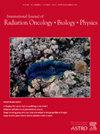Initial Clinical Experience of Cherenkov Imaging in Sub-Total Total Skin Electron Therapy Identifies Opportunities to Improve Daily Set-Up QA
IF 6.4
1区 医学
Q1 ONCOLOGY
International Journal of Radiation Oncology Biology Physics
Pub Date : 2024-10-01
DOI:10.1016/j.ijrobp.2024.07.019
引用次数: 0
Abstract
Purpose/Objective(s)
Total skin electron therapy (TSET) is a prevalent treatment modality for patients with cutaneous T-cell lymphomas. However, patient-specific QA measures for these TSET patients are lacking. Unlike isocentric treatments, there are no prior CT scans to utilize for planning, nor are there automated motion-management systems in place to ensure consistent and accurate patient positioning from day-to-day and while the patient is standing for treatment. To add additional variability, sub-total skin electron therapy patient treatments are commonly performed without treatment planning systems available to simulate and verify field edges.
Materials/Methods
To address this unmet need for patient-specific QA, we deployed a clinical Cherenkov imaging system which utilizes three cameras to capture the Cherenkov emission on the patient’s skin surface from one frontal and two lateral directions. There were 52 TSET subjects enrolled under an ongoing IRB-approved clinical Cherenkov imaging study. Amongst the 52 enrolled subjects, 7 patients were withdrawn, 7 subjects were repeat study enrollments, imaged in two separate TSET study cases, and 24 of 52 (46%) treatments were sub-total skin electron therapy cases. All 52 TSET Cherenkov study cases were manually examined to identify potential clinically relevant differences between the planned vs. observed treatment fields within the standard Stanford 6-position treatment scheme.
Results
Among the 52 Cherenkov TSET cases examined, two cases exhibited reduced dose to the upper extremities due to partial blocking, and one case saw increased dose in the subject’s left arm due to patient movement during treatment delivery. In four cases involving head blocking in the posteroanterior (PA) position, the subjects’ forearms were suboptimally aligned, parallel to the beam, rather than perpendicular to it. These specific observations were corroborated by Monte Carlo simulations, which also found reduced dose in a patient’s forearm region after accumulating skin dose from all 6 positions. Lastly, in one subject, Cherenkov imaging detected suboptimal hand positioning in the right anterior oblique (RAO) position, which was subsequently corrected for in the left anterior oblique (LAO) position. Notably, all instances of dose discrepancies or suboptimal patient positions occurred in cases with partial body blocking planned as part of the treatment, i.e. sub-total skin electron therapy.
Conclusion
When blocking is clinically indicated, modifications to the standard Stanford 6-position treatment are often required. As shown in this analysis, these modifications may increase the difference in planned vs. delivered dose to specific blocked or unblocked anatomic regions. To address these challenges, Cherenkov imaging represents a highly useful record-and-verify tool for ensuring proper patient positioning and field coverage during these more complex TSET cases.
皮肤下全电子疗法中切伦科夫成像的初步临床经验为改进日常设置质量保证提供了机会
目的/目标:全皮肤电子疗法(TSET)是皮肤 T 细胞淋巴瘤患者的一种普遍治疗方式。然而,目前还缺乏针对这些 TSET 患者的特定质量保证措施。与等中心治疗不同的是,TSET 没有事先的 CT 扫描来进行规划,也没有自动运动管理系统来确保患者从日常治疗到站立治疗时的定位始终如一且准确无误。材料/方法 为了满足这一尚未满足的患者特定质量保证需求,我们部署了一套临床切伦科夫成像系统,该系统利用三台摄像机从一个正面和两个侧面捕捉患者皮肤表面的切伦科夫发射。有 52 名 TSET 受试者参加了一项正在进行的、经 IRB 批准的临床切伦科夫成像研究。在这 52 名注册受试者中,有 7 名患者退出了研究,7 名受试者是重复注册的研究对象,分别在两个 TSET 研究病例中进行了成像,52 个治疗病例中有 24 个(46%)是次全皮肤电子治疗病例。对所有52个TSET切伦科夫研究病例进行了人工检查,以确定在标准斯坦福6位治疗方案中,计划治疗区域与观察治疗区域之间可能存在的临床相关差异。结果在检查的52个切伦科夫TSET病例中,有两个病例由于部分遮挡而导致上肢剂量减少,一个病例由于患者在治疗过程中移动而导致受试者左臂剂量增加。在四个涉及后前位(PA)头部阻滞的病例中,受试者的前臂未对准最佳位置,与光束平行,而不是垂直于光束。蒙特卡洛模拟证实了这些具体观察结果,并发现在累积了所有 6 个位置的皮肤剂量后,患者前臂区域的剂量有所减少。最后,在一名受试者身上,切伦科夫成像检测到右前斜位(RAO)的手部定位不理想,随后在左前斜位(LAO)进行了修正。值得注意的是,所有出现剂量差异或患者体位欠佳的情况都发生在计划进行部分身体阻断治疗的病例中,即亚全皮肤电子治疗。如本分析所示,这些修改可能会增加特定阻滞或非阻滞解剖区域的计划剂量与实际剂量之间的差异。为了应对这些挑战,切伦科夫成像技术是一种非常有用的记录和验证工具,可确保在这些更复杂的 TSET 病例中患者的正确定位和视野覆盖。
本文章由计算机程序翻译,如有差异,请以英文原文为准。
求助全文
约1分钟内获得全文
求助全文
来源期刊
CiteScore
11.00
自引率
7.10%
发文量
2538
审稿时长
6.6 weeks
期刊介绍:
International Journal of Radiation Oncology • Biology • Physics (IJROBP), known in the field as the Red Journal, publishes original laboratory and clinical investigations related to radiation oncology, radiation biology, medical physics, and both education and health policy as it relates to the field.
This journal has a particular interest in original contributions of the following types: prospective clinical trials, outcomes research, and large database interrogation. In addition, it seeks reports of high-impact innovations in single or combined modality treatment, tumor sensitization, normal tissue protection (including both precision avoidance and pharmacologic means), brachytherapy, particle irradiation, and cancer imaging. Technical advances related to dosimetry and conformal radiation treatment planning are of interest, as are basic science studies investigating tumor physiology and the molecular biology underlying cancer and normal tissue radiation response.

 求助内容:
求助内容: 应助结果提醒方式:
应助结果提醒方式:


